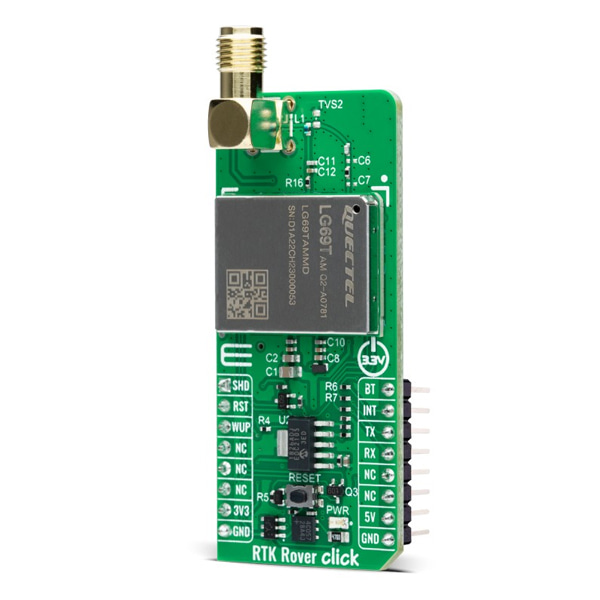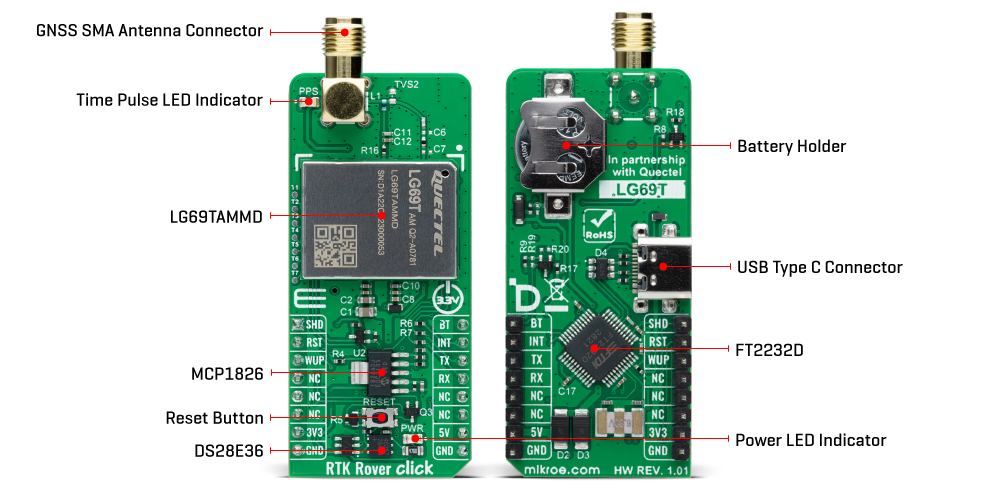GNSS RTK 로버 모듈 -LG69TAMMD
(RTK ROVER CLICK)

개요
- 본 제품은 GNSS RTK 로버 모듈 -LG69TAMMD 입니다.
- 호환되는 RTK Base station에서 정확한 위치 데이터를 보강하는 애드온 보드입니다.
- Quectel's LG69TAMMD GNSS 모듈을 기반으로 디자인된 제품으로 센티미터 수준의 측정데이터를 보여줍니다.
- GPS/QZSS, Galileo, BDS 세개의 위성신호 (NMEA 0183/RTCM 3.x protocol)를 지원합니다.
- UART 인터페이스를 가지고 있으며, 드론이나 이동 차량과 같은 위치/속도/시간 어플리케이션에 사용이 가능합니다.
- 알림: LG69TAMMD은 RTK Base station 데이터를 사용하여 RTK 기능을 Rover로써 지원합니다. 호환되는 RTK Base station은 다음 링크를 참고하십시요.
특징
-
RTK Rover Click is based on the LG69TAMMD, a multi-constellation GNSS module featuring a high-performance and high-reliability positioning engine from Quectel Wireless Solutions, that facilitates a fast and precise GNSS positioning capability. The LG69TAMMD has a dual-band supporting up to three concurrent global constellations featuring STMicroelectronics®' fifth generation positioning receiver platform with 80 tracking and four fast acquisition channels. It is characterized by a horizontal position accuracy of 1m autonomous (24h static) and 0.01m+1ppm RTK with a high performance YB0017AA mobile antenna in an open-sky environment and within 1km of the base station.

The primary function of the LG69TAMMD is PVT (RTK) which stands for Position, Velocity, and Time. Designed according to the IATF 16949:2016 standard, the LG69TAMMD comes with GPS+BDS+Galileo as a default GNSS constellation and an integrated LNA for improved sensitivity. It can receive and track GPS L1 C/A and L5 and Galileo E1 and E5a signals centered at 1575.42MHz and 1176.45MHz, and BeiDou B1I and B2a signals centered at 1561.098MHz and 1176.45MHz. The ability to receive and track BeiDou signals in conjunction with GPS results in higher coverage, improved reliability, and better accuracy.
RTK Rover Click communicates with an MCU using the UART interface, with commonly-used RX and TX pins alongside one data-ready pin (INT), which informs the host MCU to receive data when the buffer transmission is full. It is also equipped with a USB type C connector, which allows the module to be powered and configured by a personal computer (PC) using FT2232D, a compact USB to a serial UART interface device designed to operate efficiently with USB host controllers.
Before supporting the RTK navigation technique, this module must receive the RTK correction messages via its UART port. In a default configuration, it will attempt to achieve the best positioning accuracy based on the correction data it receives. When the module receives an input stream of RTCM messages, it will enter RTK float mode, and once it fixes carrier phase ambiguities, it enters RTK fixed mode. It will typically take less than 60 seconds before the Rover can solve the carrier ambiguities and go from RTK float to RTK fixed mode.
In addition to the interface pins, this board uses a few additional mikroBUS™ pins. An active-low reset signal alongside an onboard RESET button, routed on the RST pin of the mikroBUS™ socket, performs a reset function of the module, WUP pin performs module wake-up, and the SHD pin routed on the AN pin of the mikroBUS™ socket offers a switch operation to turn ON/OFF the power supply to the LG69TAMMD. The module can use Boot Download Mode for firmware update via the BT pin routed on the RST pin of the mikroBUS™ socket, alongside a blue LED indicator marked as PPS for time pulse signal information and indication. The module enters Normal operating mode by keeping the BT pin on a low logic state during the Startup sequence. Otherwise, the module enters Boot Download Mode when the pin is high during Startup.
A specific addition to this Click board™ is several testpoints that enable the use of additional module features such as RTK positioning status indicator, Wheel tick pulse signal sampled from the wheel revolution sensors, or correction UART by default or NMEA output/raw data output.
This Click board™ can operate with both 3.3V and 5V MCUs. As its main power supply, the LG69TAMMD uses 3.3V obtained from the MCP1826 LDO but also has the possibility of using an additional backup power supply in the form of a coin-shaped battery. The board must perform appropriate logic voltage level conversion before using MCUs with different logic levels. However, the Click board™ comes equipped with a library containing functions and an example code that can be used as a reference for further development.
RTK TECHNOLOGY
The Global Navigation Satellite System (GNSS) is a widely deployed and accepted means of determining precise locations without the need for the coverage or signal strength of cellular networks. GNSS combined with RTK is a solution that can realize precise real-time positioning, with positional down to the centimeter level. Quectel's ultra-compact, low-power GNSS modules, such as LG69T-AS and LG69T-AM, provided in the form of RTK Click boards™, cover the full range of requirements for high precision, dead reckoning and timing for applications as diverse as ADAS and self-driving, crewless flight, and smart agriculture.
In addition to the software support that Mikroe provides for this Click board™ in the form of libraries, functions, or example code, there is also software support provided by Quectel. Quectel's QGNSS evaluation software equips end users with an easy way to interface to Quectel GNSS modules or boards, enabling easy evaluation, testing, development and debugging of GNSS.
For all additional support questions, the customers can submit a ticket to our Technical Support or Design Service Department page.
SPECIFICATIONS
Type GPS/GNSS Applications Can be used for PVT (Position, Velocity, and Time) applications such as drones, delivery robots, precision agriculture, mining/marine management, and automotive telematics On-board modules LG69TAMMD - multi-constellation GNSS module from Quectel Wireless Solutions Key Features Dual band, centimeter-level accuracy, 80 tracking channels and 4 fast acquisition channels, high-performance, high-reliability, supports up to 3 concurrent global constellations (GPS/QZSS, Galileo, and BDS), NMEA 0183/RTCM 3.x protocol, UART and USB interface, PPS indicator, and more Interface UART,USB Compatibility mikroBUS Click board size L (57.15 x 25.4 mm) Input Voltage 3.3V,5V
문서
연관제품
- 연관제품 1